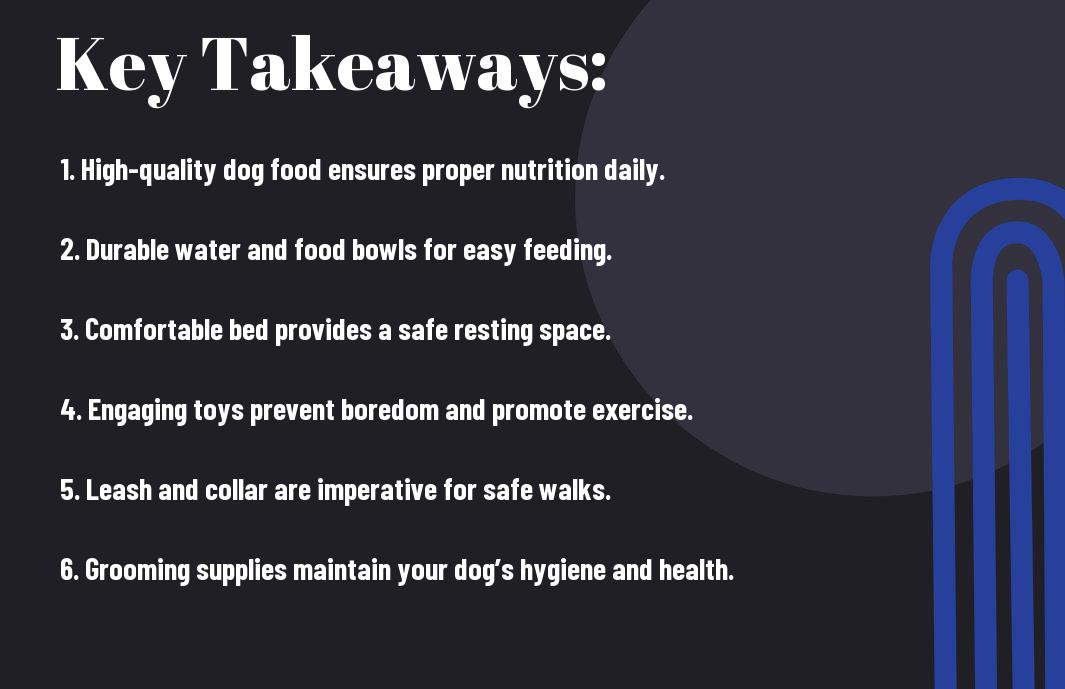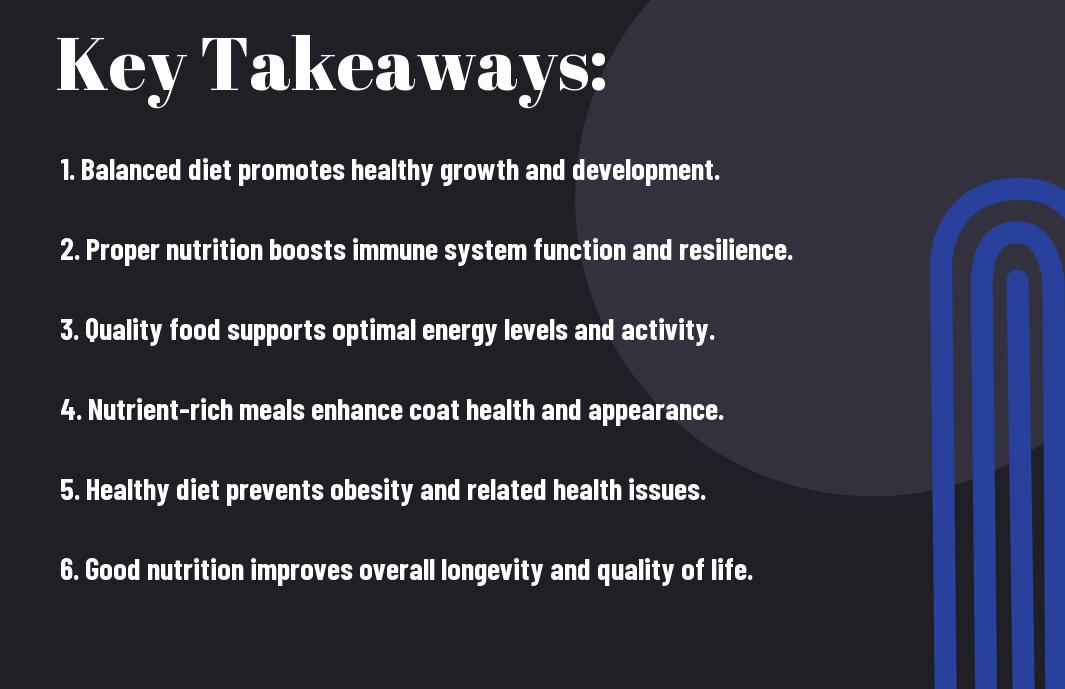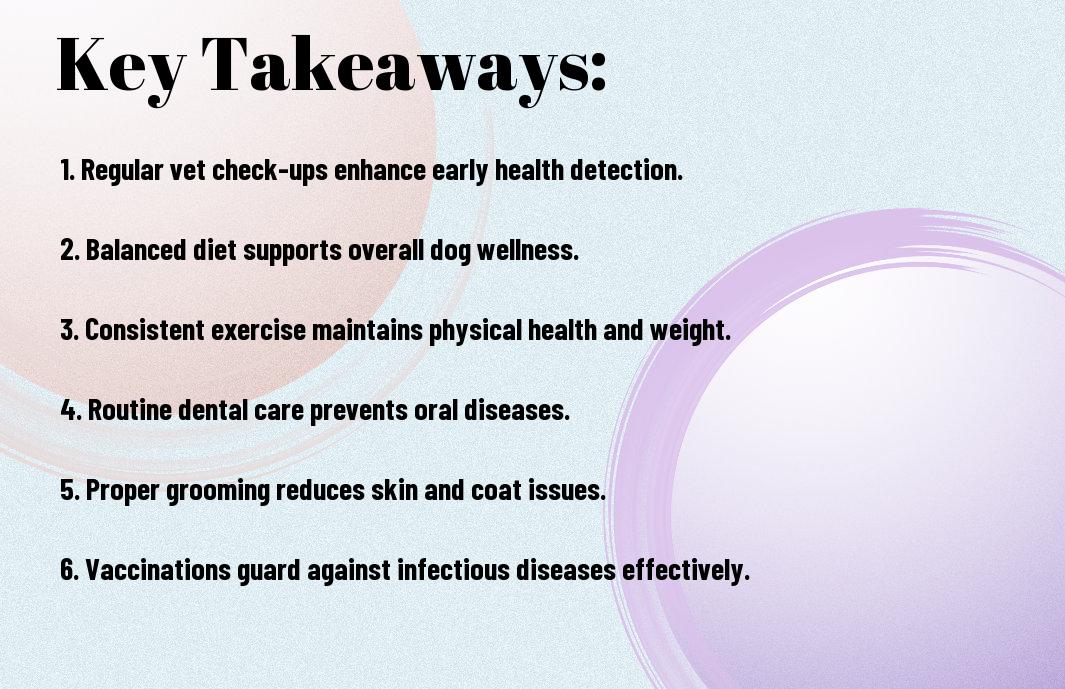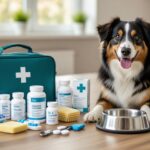Over time, you may find that your furry friend can face a variety of health challenges. This article highlights five common canine health issues and provides you with effective tips on how to prevent them. By understanding these conditions, you can take proactive measures to ensure your dog leads a happier and healthier life. Taking the right steps now can make a significant positive impact on your dog’s overall well-being.

Understanding Common Canine Health Issues
As a responsible dog owner, it is important for you to be aware of the common health issues that can affect your furry friend. Being proactive in understanding these problems can help you provide a higher quality of life for your pet. Common health issues in dogs can vary from minor ailments to severe conditions that require immediate medical attention. Familiarizing yourself with these issues will enable you to recognize potential problems early on and seek appropriate care.
Identifying the Signs of Health Problems
Assuming that your dog is healthy can sometimes put them at risk. Being attentive to any changes in your dog’s behavior, appetite, or energy levels is important in identifying potential health problems. For example, if you notice your dog is sleeping more than usual, is reluctant to engage in play, or has a decreased appetite, these could be signs that something isn’t right. Physical symptoms such as vomiting, diarrhea, or unusual lumps could indicate underlying health issues that require veterinary attention.
Additionally, it helps to know what is typical for your dog’s breed and age, as some breeds are predisposed to certain conditions. If you observe any worrying signs or symptoms, it’s important to consult with your veterinarian as soon as possible to ensure your dog’s health and well-being.
The Importance of Regular Vet Check-Ups
If you want to keep your dog healthy, regular vet check-ups are fundamental. These visits allow your veterinarian to conduct thorough examinations that can help catch potential health issues early. Routine screenings, vaccinations, and preventive care can contribute significantly to your dog’s overall health and may save you from heartache and expensive treatments down the line.
Signs of underlying health issues in dogs can often go unnoticed, and preventative care can help you address these problems before they escalate. By maintaining regular appointments with your veterinarian, you stay informed about your dog’s health status and receive guidance on how to best support your furry friend’s needs.

Canine Obesity
One of the most prevalent health issues facing dogs today is canine obesity. This condition not only affects a dog’s appearance but can also lead to serious health complications, including diabetes, joint problems, and heart disease. Understanding the factors that contribute to obesity will empower you to make informed decisions regarding your dog’s health and weight management.
Factors Contributing to Obesity in Dogs
Clearly, several factors play a significant role in the development of obesity among dogs. The most common contributors include:
- Overfeeding and lack of controlled portions
- Lack of exercise due to lifestyle or health issues
- High-calorie diets that don’t meet nutritional needs
- Genetics which can predispose certain breeds to weight gain
Knowing these factors can help you identify potential risks in your dog’s daily routine and make adjustments to promote a healthier lifestyle.
Tips for Maintaining a Healthy Weight
Assuming you want your dog to live a long and healthy life, it’s imperative to focus on maintaining a healthy weight. Here are some effective strategies to consider:
- Regular exercise is imperative—aim for daily walks or playtime
- Administer portioned meals rather than free-feeding
- Monitor treats and make sure they don’t exceed 10% of daily caloric intake
- Regular vet check-ups to determine weight and assess overall health
Perceiving these elements as integral parts of your dog’s routine can significantly reduce the risks associated with obesity.
To implement a successful weight management program, consistency and dedication on your part are key. Engaging in regular activities, providing balanced nutrition, and limiting high-calorie treats are incredibly effective methods. Consider involving your vet in this process to help tailor a plan specifically for your dog, ensuring you both have the right expectations and goals.
- Transition to high-quality dog food that meets your pet’s specific needs
- Utilize activity trackers to gauge and increase daily exercise
- Gradually reduce caloric intake if your dog is overweight
- Be consistent with feeding schedules to regulate weight
Perceiving your dog’s health as a priority requires ongoing effort and commitment to preventative measures.
How-To Implement an Effective Diet Plan
The formulation of an effective diet plan can have a profound impact on your dog’s weight management. Start by selecting a nutritional diet catered to your dog’s specific age, size, and health requirements. Consulting your veterinarian will provide insights into the right food options and portions based on your dog’s current weight and ideal goal.
Canine weight management involves a thorough understanding of calorie intake and expenditure. Using resources like online calorie calculators or nutrition guides can be beneficial in setting dietary guidelines. Tailor the diet plan to gradually adjust your dog’s caloric intake so that the weight loss is steady and sustainable. Always keep in mind the importance of combining this with appropriate exercise levels.

Dental Disease
Now, if you’re a dog owner, you may not realize just how vital dental health is for your canine companion. Dental disease is one of the most prevalent issues among dogs, affecting approximately 80% of dogs by the age of three. It begins with the buildup of plaque, which can eventually lead to more serious problems, including gum disease and tooth decay. The good news is that with proper care, you can significantly reduce the risk of dental issues for your furry friend.
Signs of Dental Disease in Dogs
Dental disease in dogs can often go unnoticed until it has progressed significantly. Signs that your pet may be suffering include bad breath, difficulty eating, or a noticeable change in their eating habits. Additionally, you might notice redness or swelling in the gums, tartar buildup on the teeth, or even loose teeth. Your dog’s behavior may also change; they may become irritable when their mouth is touched or show signs of pain while eating.
In some cases, dental disease can lead to more severe health problems, such as infections that can affect the heart, liver, and kidneys. Therefore, keeping an eye on your dog’s oral health is vital for their overall well-being. Scheduling regular check-ups with your veterinarian is a great way to ensure you catch any early signs of dental disease.
How-To Establish a Dental Care Routine
HowTo keep your dog’s teeth healthy and prevent dental disease starts with establishing a regular dental care routine. Brush your dog’s teeth at least two to three times a week with canine toothpaste that is safe for them. Introduce this process gradually, allowing your dog to get used to the toothbrush and the taste of the toothpaste before adding frequent brushing sessions. Consider incorporating dental chews and toys into their playtime to help naturally clean their teeth.
The key to maintaining your dog’s oral health lies in consistency. Make dental care a regular part of your routine, just like feeding and walking your dog. By doing so, you not only help prevent dental disease but also strengthen your bond with your furry friend. Don’t hesitate to consult with your veterinarian for tailored advice on the best dental practices and products for your dog.
Tips for Choosing the Right Dental Products
Clearly, selecting appropriate dental products can impact your dog’s oral health significantly. Choose toothbrushes designed specifically for dogs, as well as specially formulated toothpaste that does not contain xylitol, which is toxic to pets. Look for dental chews that have the Veterinary Oral Health Council (VOHC) seal of acceptance, as these are proven to help reduce plaque and tartar buildup. Ensure any water additives or rinses are safe for your pet and effective against dental disease.
When in doubt, consult your veterinarian for recommendations tailored to your dog’s specific needs. They can help you understand which products will work best based on your dog’s age, breed, and dental history.
- Toothbrushes designed for dogs
- Canine toothpaste
- Dental chews with VOHC approval
- Water additives that are safe
Perceiving the importance of choosing the right dental products can make a significant difference in maintaining your dog’s overall dental health.
The *further* you go in prioritizing your dog’s dental care, the more rewarding it becomes for both of you. You’ll develop a healthy habit that will lead to more joyful and fulfilling moments together. Investing in quality dental care products ensures your pet stays happy and healthy throughout their life.
Additional notes about selecting dental products can help solidify your understanding of their significance. Look for products that focus on fighting *plaque*, *tartar*, and *bad breath*, ensuring effectiveness in your dog’s routine. Consult with your veterinarian for insights on the best options available.
- Products that fight plaque
- All-natural dental cleansers
- Approved dental chews
- Flavorful canine toothpaste
Perceiving the difference quality products can make will enhance the effectiveness of your dental care regimen for your dog.
Fleas and Ticks
Unlike other health issues, fleas and ticks can thrive almost anywhere, making prevention and control important. These parasites not only cause discomfort for your dog but can also lead to serious health concerns such as allergic reactions, infections, and the transmission of diseases. Understanding the factors that attract these pests can help you create a safe environment for your canine companion.
Factors That Attract Fleas and Ticks
Now, let’s explore some of the factors that can make your home and yard appealing to fleas and ticks:
- Warm, humid environments—ideal for flea development
- Overgrown vegetation—provides cover for ticks to thrive
- Access to other infested animals—wildlife can transport fleas and ticks
- Poor grooming habits—resulting in an environment conducive to parasites
This information can guide you in making environment adjustments to effectively reduce the chances of an infestation.
How-To Prevent Flea and Tick Infestations
On a proactive note, there are several strategies you can implement to prevent fleas and ticks from invading your space. Regularly applying veterinary-approved flea and tick preventatives is one of the most effective methods. Furthermore, maintaining a clean and hygienic environment through frequent cleaning of your pet’s bedding and your home is important. Outdoor areas should be regularly trimmed to eliminate overgrown foliage, which can serve as a habitat for ticks.
Fleas can rapidly breed in your living space, but by establishing a routine that includes product use and environment maintenance, you significantly reduce the risk of infestation. Consulting your veterinarian about the best flea and tick prevention options tailored to your pet’s health and lifestyle is also an important step.
Tips for Treatment and Control
On the unfortunate occasion that your dog does get infested with fleas or ticks, it’s vital to know how to treat the issue effectively. Start by administering a veterinary-approved flea and tick treatment to your dog immediately. Bathe your pet using specialized flea shampoo, and consider sweeping away any parasites found in their fur. Secondly, treating your home and yard with appropriate insecticides or contacting a pest control professional can help eradicate the infestation.
- Apply topical treatments or oral medications—provided by your veterinarian
- Wash your pet’s bedding regularly—to eliminate hidden fleas and eggs
- Vacuum your home frequently—to remove fleas from carpets and upholstery
- Maintain a tick-free yard—by regular maintenance and careful landscaping
Assume that fleas and ticks can persist despite your efforts. Maintaining vigilance and consistent treatments will support the ongoing wellbeing of your dog.
Understanding flea and tick infestations can lead to effective treatment plans that prioritize your pet’s health. Be proactive and consult with your veterinarian to establish the most effective strategies to keep your dog and home free from these nasty parasites.
- Stay informed about local flea and tick populations—to monitor risk
- Utilize environmental control measures—to reduce the likelihood of infestation
- Combine treatments for maximum effectiveness—using veterinary guidance
Assume that taking preventive measures is an ongoing task that is important for your pet’s comfort and safety.
Allergies and Skin Conditions
Your canine companion can experience a range of allergies and skin conditions that may affect their well-being over time. These issues can stem from various sources, including environmental factors and food-related ingredients. Understanding these allergies and how to prevent them is imperative for ensuring your dog leads a comfortable and healthy life.
Common Allergens Affecting Dogs
An increasing number of dogs are developing sensitivities to common allergens, which can lead to distressing symptoms. Some of these allergens include pollen, dust mites, mold, certain food proteins (such as beef, chicken, or grains), and flea saliva. Each of these substances can trigger an allergic response, resulting in an array of skin conditions, including itching, redness, and inflammation.
Additionally, environmental factors play a significant role in aggravating allergies. For instance, seasonal changes may introduce your dog to new pollen and mold spores in the air. Recognizing these common allergens can help you take proactive steps in reducing your dog’s exposure and managing any potential allergic reactions.
How-To Recognize Allergy Symptoms
Little signs of allergies can often be overlooked, but it’s crucial to be aware of the symptoms your furry friend displays. Allergies usually manifest through persistent itching, scratching, and licking of the paws or skin. Other common indicators include skin rashes, redness, and even ear infections. You may also notice your dog shaking their head frequently or seemingly uncomfortable when touched in certain areas.
Allergy symptoms can affect your dog’s quality of life significantly, leading to increased anxiety or irritability. If you observe any of these signs, it’s important to consult with your veterinarian, who can help determine whether it’s indeed an allergy and not another underlying health issue.
Tips for Managing Allergies
Allergens are pervasive, but there are effective steps you can take to help manage your dog’s allergies. Here are some strategies to consider:
- Regularly groom your dog to remove allergens from their coat.
- Install air purifiers in your home to reduce airborne allergens.
- Keep your dog’s living area clean and dust-free.
- Avoid low-quality dog foods that may contain allergens.
The key to managing your dog’s allergies lies in identifying the specific triggers and taking proactive measures.
It’s also beneficial to consult with your veterinarian for possible allergy testing and recommendations on dietary changes or medications that may alleviate your dog’s symptoms. Keeping track of what works and what doesn’t can greatly improve your dog’s comfort and happiness.
- Consider consulting with an allergist for specialized care.
- Monitor for any changes in your dog’s condition after altering their diet or environment.
- Be attentive to your dog’s response to treatment options.
The more informed you are about your dog’s allergies, the better equipped you’ll be to manage them effectively.
Ear Infections
To maintain your dog’s well-being, it is crucial to be aware of ear infections, a common health issue that can cause discomfort and pain in your furry friend. These infections can arise from various factors, and understanding these can help you take preventive measures.
Factors Leading to Ear Infections in Dogs
Infections can result from several underlying causes. For instance, dogs with floppy ears often experience moisture buildup, making their ears prime candidates for bacteria and yeast proliferation. Other factors that may lead to ear infections in dogs include:
- Allergies that cause inflammation
- Excessive scratching or pawing at the ears
- Infection from parasites like fleas or ticks
- Water exposure from swimming baths or grooming
Recognizing the signs early can make a significant difference in your dog’s recovery and comfort.
How-To Clean Your Dog’s Ears Safely
Some dog owners may feel hesitant about cleaning their pet’s ears, but proper cleaning is vital for preventing ear infections. Begin by gathering the right supplies, such as a dog ear cleaner, cotton balls, and treats for positive reinforcement. Gently lift the ear flap and apply the ear cleaner according to the product instructions. Massage the base of the ear for a few seconds to ensure the cleaning solution reaches deep within the ear canal, and then allow your dog to shake its head to expel any excess fluid.
Leading a cleaning routine can keep your dog’s ears healthy. After cleaning, use a cotton ball to wipe away any dirt or debris you can see in the ear flap and outer ear. Avoid using cotton swabs, as they may push debris further down the ear canal. Regular cleaning reduces the likelihood of moisture buildup and keeps infections at bay.
Tips for Preventing Future Infections
Ears are sensitive areas, so it’s important to keep them clean and dry to protect your dog from potential ear infections. Here are some effective tips to help prevent future infections:
- Regularly check your dog’s ears for dirt or wax buildup
- Keep your dog’s ears dry after baths or swimming
- Avoid using human products on your pet’s ears
- Consult your veterinarian for any persistent ear issues
The more proactive you are in caring for your dog’s ears, the more likely you are to prevent infections from occurring in the first place.
Plus, staying informed about the signs of ear infections can help you catch them early. Look for symptoms such as incessant scratching, head shaking, or unpleasant odors, and consult your veterinarian if you notice any of these signs. Early intervention is key in ensuring your furry friend remains healthy and comfortable.
To wrap up
Conclusively, being proactive about your dog’s health can significantly reduce the risk of common health issues such as obesity, dental disease, arthritis, skin allergies, and parasites. By maintaining a balanced diet tailored to your dog’s needs, you can help manage their weight effectively. Regular dental checkups and at-home dental care will keep their teeth and gums healthy, while consistent exercise not only prevents obesity but also strengthens their joints and muscles, thus reducing the risk of arthritis as they age.
Additionally, being vigilant about skin care will aid in identifying allergies early on, allowing for timely treatment. Keeping up with a reliable parasite prevention plan will safeguard your dog against common infestations. By investing time and resources for the well-being of your furry friend, you can ensure they lead a happy and healthy life, ultimately strengthening your bond with them in the process.
FAQ
Q: What are the most common health issues in dogs?
A: Some of the most prevalent health issues in dogs include obesity, dental disease, ear infections, skin allergies, and arthritis. Each of these conditions can significantly affect your dog’s well-being and quality of life if left unaddressed.
Q: How can I help prevent obesity in my dog?
A: Preventing obesity in your dog involves providing a balanced diet and ensuring regular exercise. Consult with your veterinarian to determine the appropriate portion sizes and caloric intake for your dog’s breed and activity level. Engage your dog in daily physical activities, such as walks, playtime, and interactive toys, to promote an active lifestyle.
Q: What steps can I take to avoid dental problems in my dog?
A: To prevent dental issues in dogs, establish a regular dental care routine that includes brushing your dog’s teeth several times a week, providing dental chews or toys designed to reduce plaque, and scheduling professional dental cleanings with your veterinarian. Additionally, incorporating a diet that supports oral health can be beneficial.










